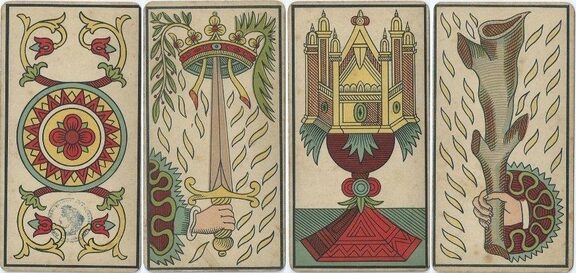The most popular Tarot deck in the world is the Rider-Waite-Smith, created in 1910.
The reason this deck was so successful was because it was the first mass-produced deck marketed to the general public with full scenes on all of the cards, rather than just ornamental suit emblems. This made it more accessible for some, because one could clearly see a story in each scene, which helped with interpretation, and also as a memory aid. Nowadays, the images on most Tarots are inspired by this one.
However, the Tarot existed nearly 500 years before Waite and Smith's deck was created! So, there is really a rich tradition of pre-Rider decks out there which are quite interesting, some very beautiful, and all worthwhile to explore. Some people shy away from these because they seem to hard to read without the illustrated scenes, but I hope to inspire some of you to try them.
One of the reasons I prefer decks with pips is that it encourages the intuition. Without a particular scene on the card which may only illustrate particular meanings, it opens the possibilities for what a card can signify. There is more room for intution emerge, because you don't have to fit your interpretation to what is depicted literally on the card. In this way, the cards can become more of a catalyst for the divinatory process to happen.
When you look at an image which is more sparse, perhaps just a few cups and some vines, or a bunch of wands crossing over each other, you need to look at it in a more abstract fashion-- like the way you might have seen shapes in clouds, as a child.
Ten straight wands crossing each other might look like a gate, or a woven tapestry, or a net, or a waffle, or many other things. Perhaps the vines around the 5 of cups are reminicent of snakes, or ribbons, or arms, or something else.
The ornamental flowers and vines may look simple at first glance, but with a keen eye, you will see many differences in the decoration on each card.
Some show buds; some flowers; some leaves; and some fruit.Some vines seem to delicately offer up the suit emblems, and some seem to close in on them. Some look like they are growing, some appear to wither. All of these things can create a different feel in a reading.
When you place cards next to each other in a spread, you can examine the development of complexity from one to the next. Each suit begins with a very simple image at the ace, and the cards become more 'full' as the suit progresses towards the ten. You can look at the order in which your cards appear, and see if you can find a story in the way the suit emblems fall. Perhaps the cards look closed and rigid at the beginning, and then become more fluid towards the end, or maybe a couple of busy-looking cards on the edges flank one which appears strong and powerful in the middle. The arrangement of the cards can show how the energy is flowing in a situation.
The other method of reading these types of decks is more analytical. Being familiar with a system of symbolism which gives each of the suits a meaning, as well as each of the numbers, creates a method where you can find the meaning by combining the two symbols. Usually, each of the suits will refer to one area of a person's life, and the number will express what is happening in that realm of being.
Various occultists over time have assigned different series of correspondances to all of the Tarot cards, and they do not all agree! If you use a historical deck which was not created with a particular esoteric agenda in mind, you can study various systems of attributions, and choose to use those which you feel make the most sense, as none are shown directly on the cards.
If you would like to try reading with one of these decks, there are a number of readily-available modern editions of antique Tarots. You might try a Visconti-- This is the oldest known Tarot! --or you might try the 1JJ Swiss, or the Ancient Tarot of Bologna, or the Ancient Italian. There are many versions of Marseilles decks avaiable, whose major arcana greatly influenced the Rider.
For a wholely modern deck, the Crystal Tarot by Elisabeth Trevisan has amazingly beautiful, stained-glass-like images on all of the cards, but the minors don't have full scenes.
If you find you like this style of cards, a wide variety of beautiful collectors' editions of antique decks can be found online, from small European publishers.
Once you begin to read with this type of Tarot, it opens a whole new world of decks to explore, and you may learn some interesting things about where modern tarot iconography came from, along the way!
